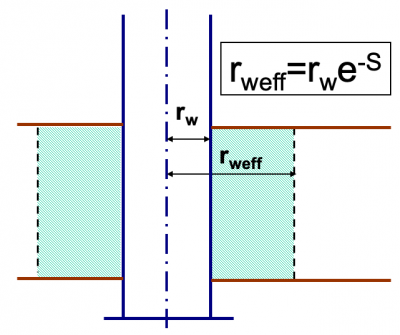Difference between revisions of "Prats effective well radius"
From wiki.pengtools.com
| Line 7: | Line 7: | ||
*For damaged wells the effective well radius is lower than the wellbore radius. | *For damaged wells the effective well radius is lower than the wellbore radius. | ||
*For undamaged wells the effective well radius is equal to the wellbore radius. | *For undamaged wells the effective well radius is equal to the wellbore radius. | ||
| + | |||
| + | :<math>r_{w_{eff}}=r_w e^{-S}</math> | ||
{{Quote| text = It appears that the behavior of vertically fractured reservoirs can be interpreted in terms of simple radial-flow reservoirs of large wellbore. | source = Prats, 1961}} | {{Quote| text = It appears that the behavior of vertically fractured reservoirs can be interpreted in terms of simple radial-flow reservoirs of large wellbore. | source = Prats, 1961}} | ||
| − | |||
| − | |||
===Skin equation=== | ===Skin equation=== | ||
Revision as of 06:07, 28 April 2020
Prats effective well radius equation
Effective well radius is a radius value at which well is draining the reservoir under the radial flow conditions.
- For stimulated wells the effective well radius is higher than the wellbore radius.
- For damaged wells the effective well radius is lower than the wellbore radius.
- For undamaged wells the effective well radius is equal to the wellbore radius.
It appears that the behavior of vertically fractured reservoirs can be interpreted in terms of simple radial-flow reservoirs of large wellbore.— Prats, 1961
Skin equation
Nomenclature
 = wellbore radius, length
= wellbore radius, length = effective well radius, length
= effective well radius, length = skin factor, dimensionless
= skin factor, dimensionless = fracture half length, length
= fracture half length, length
References
- Prats, M., Hazebroek, P., and Strickler, W.R. 1962. Effect of Vertical Fractures on Reservoir Behavior--Compressible-Fluid Case. SPE J. 2 (2): 87-94.



